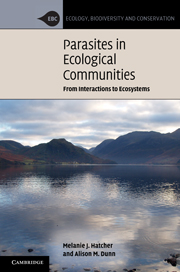Book contents
- Frontmatter
- Contents
- Acknowledgements
- List of abbreviations
- 1 Introduction
- 2 Parasites and competitors
- 3 Parasites and predators
- 4 Parasites and intraguild predation
- 5 Plant pathogens and parasitic plants
- 6 Parasites and invasions
- 7 Ecosystem parasitology
- 8 Emerging diseases in humans and wildlife
- 9 Where do we go from here?
- References
- Index
1 - Introduction
Published online by Cambridge University Press: 05 August 2012
- Frontmatter
- Contents
- Acknowledgements
- List of abbreviations
- 1 Introduction
- 2 Parasites and competitors
- 3 Parasites and predators
- 4 Parasites and intraguild predation
- 5 Plant pathogens and parasitic plants
- 6 Parasites and invasions
- 7 Ecosystem parasitology
- 8 Emerging diseases in humans and wildlife
- 9 Where do we go from here?
- References
- Index
Summary
Ring a ring of roses,
A pocket full of posies,
Atishoo, atishoo,
We all fall down.
Sporadic reports appear of a mysterious disease afflicting people in a far-off country. Within weeks the disease has spread to towns and cities and is reaching epidemic proportions in that country, and within months it has circulated around the world. The origins of this new disease are initially unclear but, mysteriously, large-scale die-offs of wildlife and domestic animals presage the outbreaks in several countries. Many people and animals die; furthermore, we start to see changes throughout natural communities, involving the resources and consumers of afflicted species. Eventually the disease dies out in humans and domestic stock, and the infection, if it persists, goes largely unnoticed in a handful of wildlife species. What was going on? Could we prevent it happening again, and will there be long-term consequences for natural communities? This is the plot behind many B-movies, but also something that happens in reality all the time. For example, the recent sporadic outbreaks of highly pathogenic avian flu involve transmission though a suite of wildfowl and domestic bird species, with occasional spillover into man. At the turn of this new century, as West Nile virus (WNV) spread throughout the United States, its arrival in a new county was heralded by reports of dead and dying birds, also host to the virus.
- Type
- Chapter
- Information
- Parasites in Ecological CommunitiesFrom Interactions to Ecosystems, pp. 1 - 19Publisher: Cambridge University PressPrint publication year: 2011

